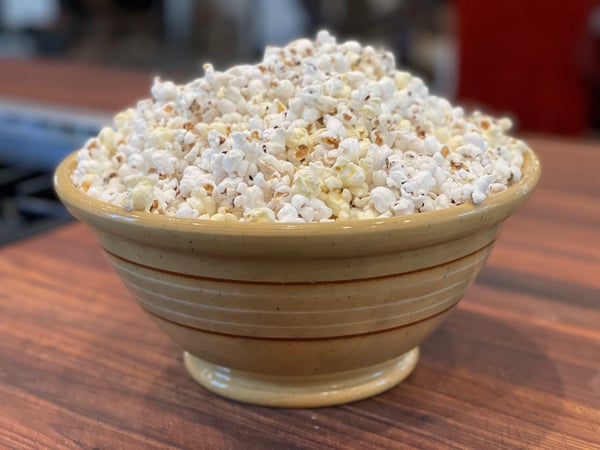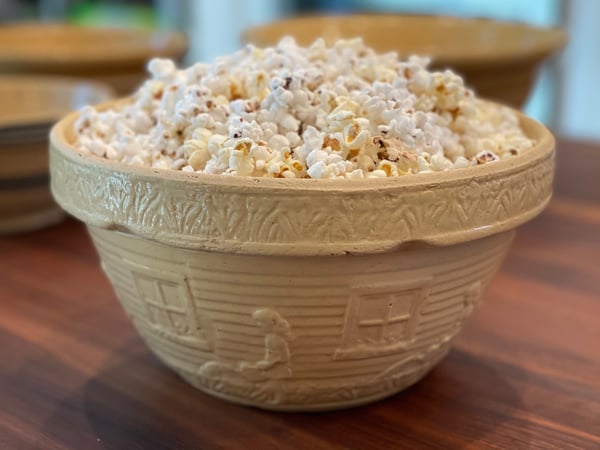Before I write a blog, I like to see what videos, recipes and overall content is available online. I was surprised to find how little information there is on popping popcorn, especially since I know a lot of people struggle with making popcorn. It seems the simplest of recipes are often the ones most underrepresented. I did find plenty of content on the subject of soaking popcorn prior to popping it. Apparently soaking makes for rather soggy and unfluffy popcorn. Is that really a surprise? I found a lot of recipes with suggestions for fun seasonings and toppings, but not much information on how to actually pop it successfully. Our own blog library offered a great blog on the history of popcorn, but again, nothing really detailed on how to pop it.

I do not find fault in Alton’s recipe or technique, but what I wanted to lay out for you is how to make perfectly popped popcorn in a more traditional manner. My technique achieves what Alton’s recipe does, but it doesn’t require a recipe to make it and you can easily make more or less popcorn. I know that sometimes I want a little bit of popcorn and sometimes I want a whole lot of popcorn. When I want popcorn, I really don’t want to rely on a recipe, it’s something I just want to know how to do.

Step 1: Match the Pan Size to the Quantity of Popcorn you Want
What size pot to use? Well, how much popcorn do you want to eat? If you want a giant bowl of popcorn, use a really big pot like an 8-quart stock pot or even larger. When we pop popcorn at The Chopping Block, we use a 50-quart stock pot, which make enough popcorn to fill a large garbage bag! If you want a small amount of popcorn, you might chose a 3-quart stock pot, and if you want a dainty portion of popcorn, use a 1-quart pot.
If you follow the instructions below, the popcorn should fill your pan halfway to three-fourths of the way to the top, depending on the type of popcorn you use. Think about what bowl or bowls you will be eating out of and match the pot you will cook the popcorn in to the size of the bowl you want to fill.
If you don’t have a heavy gauge pot, you can still make great popcorn. Reduce the temperature when you are popping your popcorn from high heat to medium high, and make sure to shake the pot regularly to move the kernels around and keep them from burning.
Step 2: Use the Right Ingredients
Picking Popcorn
I think you can make great popcorn with any variety of popcorn kernel. One of the great things about popcorn is it is generally inexpensive and readily available. I personally prefer an heirloom kernel; they tend to be crunchier and more flavorful than the bagged kernels you get at the supermarket.
However, those more generic bags of popcorn tend to yield a fluffier popcorn, and this is the type of kernel we use at The Chopping Block. That big fluffy popcorn may be more squeaky and chewy but sometimes that is just what you want, a big bowl of fluffy popcorn. Whether you use a store brand or an heirloom variety, they both cook the same way, but since the heirloom varieties are less fluffy, that means they will produce less popcorn.
I primarily use grapeseed oil to pop popcorn, but avocado oil or peanut oil also work great. These are neutral oils that can handle high heat without burning and smoking. The other option is to pop your popcorn in ghee or clarified butter. Popping in ghee or clarified butter is great because you get the added flavor, and you might find you can skip buttering the popcorn. Both ghee and clarified butter have the milk solids and water removed so they can withstand the high temperature required for popping popcorn.
Fat for Topping
Over the years, I have abandoned topping my popcorn with butter. It isn’t for health reasons or a disdain for butter, but rather that I like that the texture of the popcorn better without it. Without oil or butter, the popcorn remains crunchy. I use a good amount of oil to pop the popcorn and that fat seasons and flavors the popcorn. When I do want buttery popcorn, I pop in clarified butter or ghee. You’ll be surprised how much butter flavor you can get that way.
That said, I understand you may want to add butter, so if you do, I recommend using clarified or ghee if you can, since the water is removed in both which will help keep your popcorn from getting soggy. When I feel like I want a richer popcorn, my go to topping is olive oil. It also helps to retain the crunch. It is easy to apply and your leftover popcorn keeps better! Just a quick drizzle of olive oil or other flavored oil will do the trick.
We are known for our Truffled Popcorn at The Chopping Block, and we serve a staggering amount of it in our retail stores, classes and private events. All we do is pop the popcorn, drizzle it with our favorite Frantoia Olive Oil and sprinkle it with The Chopping Block’s Truffle Salt (a little black pepper and grated parmesan takes it over the edge!). One of the reasons that our truffle salt works so well on the popcorn is because it is very fine salt. That’s really the trick: a sprinkle of good quality, very fine sea salt. The fine salt sticks to the popcorn and allows you to use a much smaller amount of salt. As much as I love Kosher salt, it just falls off the popcorn.
Very fine salt is great for baking, sprinkling on fried foods or in vinaigrettes and cold dishes where the salt won't dissolve.
Pro Tip: You can also take larger grained sea salt and grind it in a mortar and pestle until super fine.
Step 3: Popping 101
At this point, you have selected the pot appropriately sized for your popcorn consumption. Place that pot on the stove and add a layer of oil or ghee to cover the bottom of the pan evenly. If you add more than you need it will either absorb into the popcorn or be left in the bottom of the pan, so no need to overthink this. Just make sure the entire surface is covered with a thin layer of oil or ghee, and you should be good.
Add an even layer of popcorn. This is really the trick to good popcorn: do not pile the popcorn in the pan. When you pile the kernels so that they are on top of each other, they won’t pop properly. The kernels sitting on the top can’t hit the heat source, and they don’t pop well, so there will be a lot of un-popped popcorn in your pan.
Turn the heat on high and put the lid on the pan (do not preheat your pan). Once the popcorn starts to pop give it a couple of shakes to ensure the kernels are shaken down to the bottom of the pan.
Leave the heat on until the popcorn stops popping. As soon as it stops popping, remove the pan completely from the stove and dump into your bowl. If you leave the popcorn in the pan or on the stove the residual heat from the pan and the burner can burn the popcorn even after you turn it off. Get that popcorn out of the pot immediately and into a bowl!
If you want to add butter or oil, give a light drizzle and sprinkle of salt to taste. I like to add salt and oil a little at a time, tossing after each addition.
If you need a cocktail to go with that popcorn, we have Virtual Cocktails: Rum 101 coming up on Saturday, March 20 at 5pm CST. Spirits Expert Christophe Bakunas will take you on an informative and enlightening journey into the three main styles of rum - British, Spanish and French - in this fun virtual class, and you'll sip on:
- Hotel Martinique House Cocktail
- Hemingway Daiquiri
